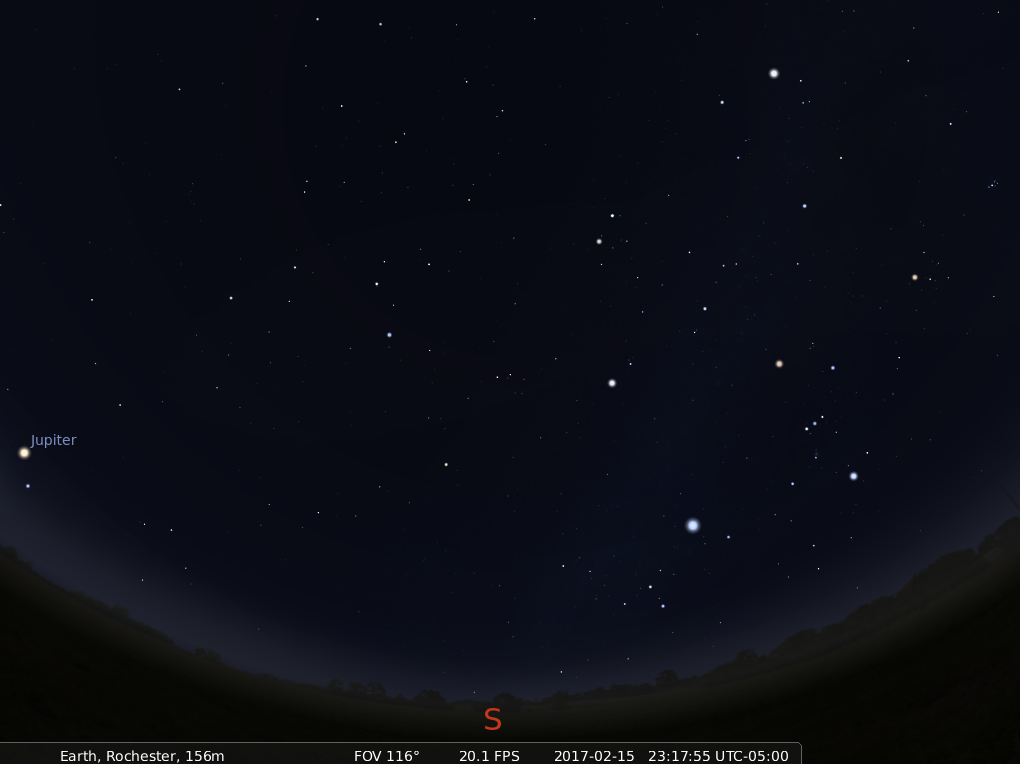
 Copyright © Michael Richmond.
This work is licensed under a Creative Commons License.
Copyright © Michael Richmond.
This work is licensed under a Creative Commons License.
Contents
If you go outside tonight around midnight, and look to the south, you'll see this:

Q: Can you identify any constellations?
Q: Are any of those Centaurus?
Perhaps this will help.
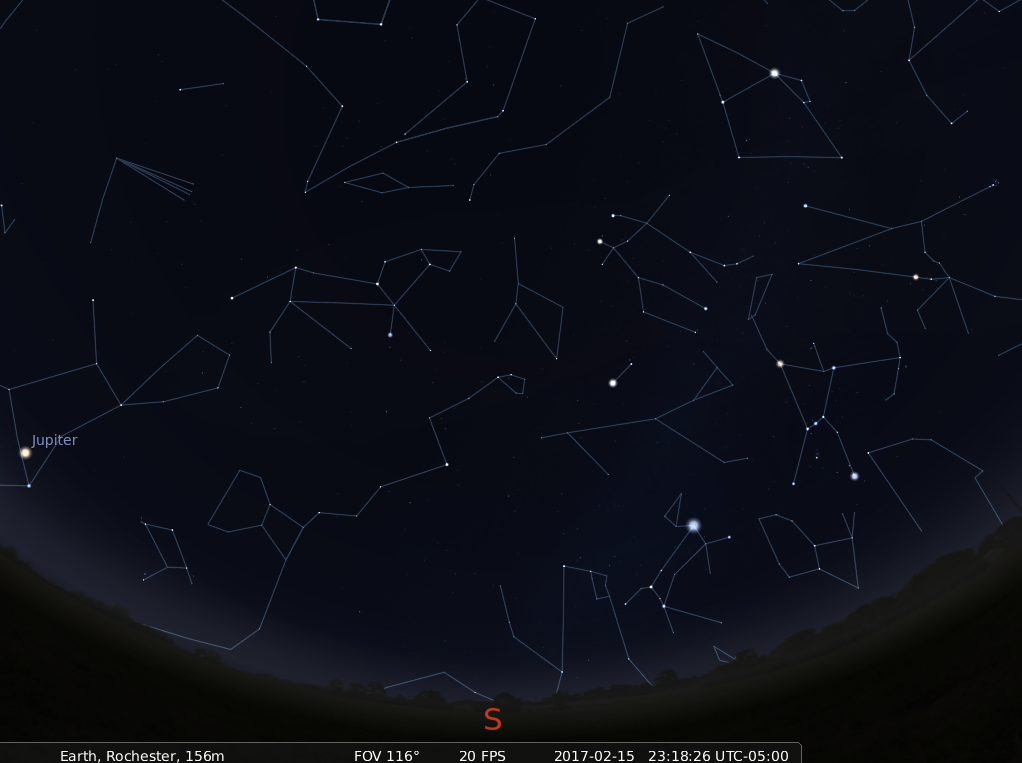
Of course, the answer to the second question is "No." We can't see the stars of Centaurus from Rochester, NY. It lies in the southern celestial hemisphere, too far south for us to see.
So, let's go to Australia, and try again!
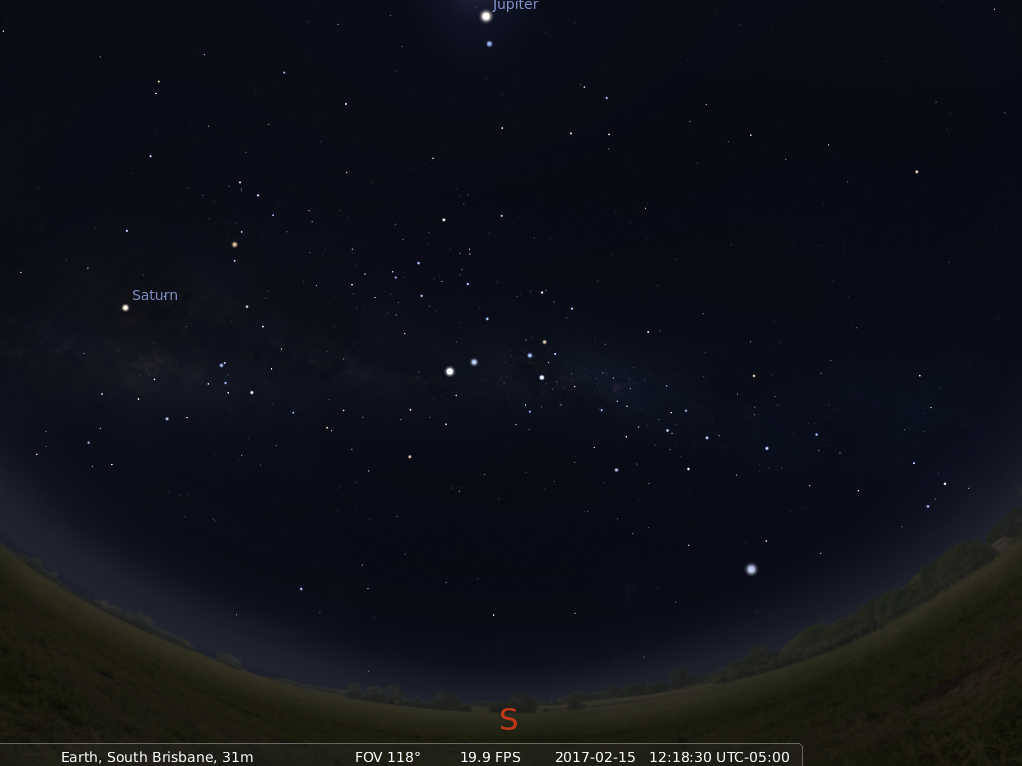
Q: Can you identify any constellations?
Q: Are any of those Centaurus?
Perhaps this will help.
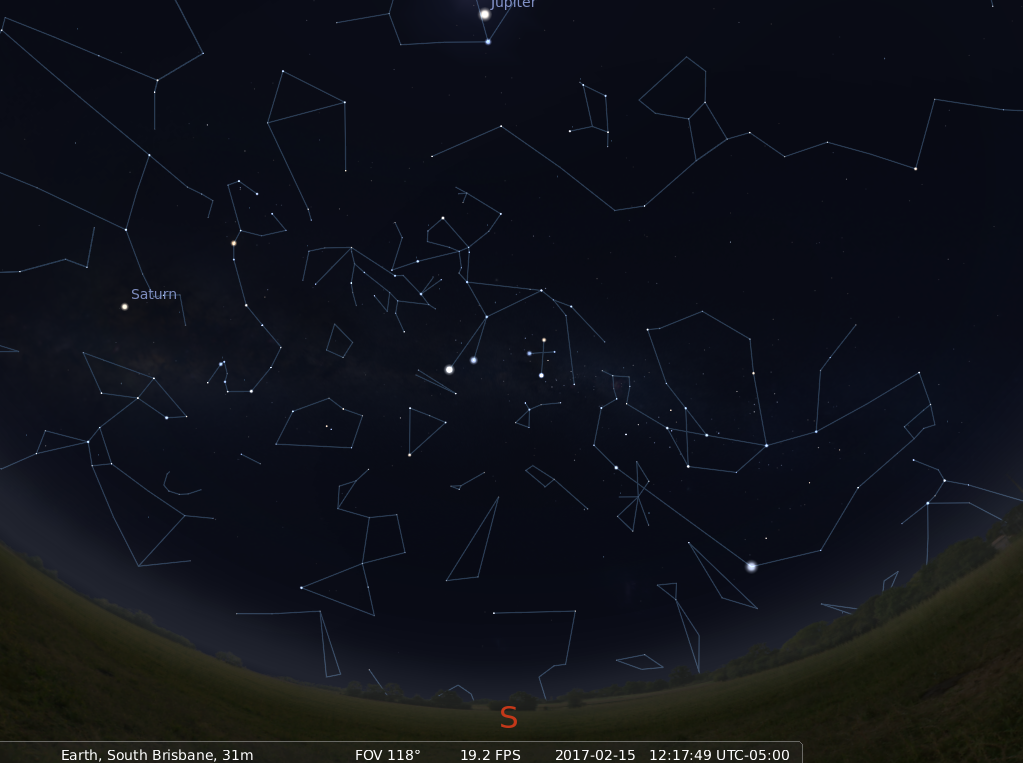
There it is! Sitting high in the southern sky is the constellation of Centaurus, the centaur. A bright star marks each of his forefeet; the brighter of the two is Alpha Centauri.
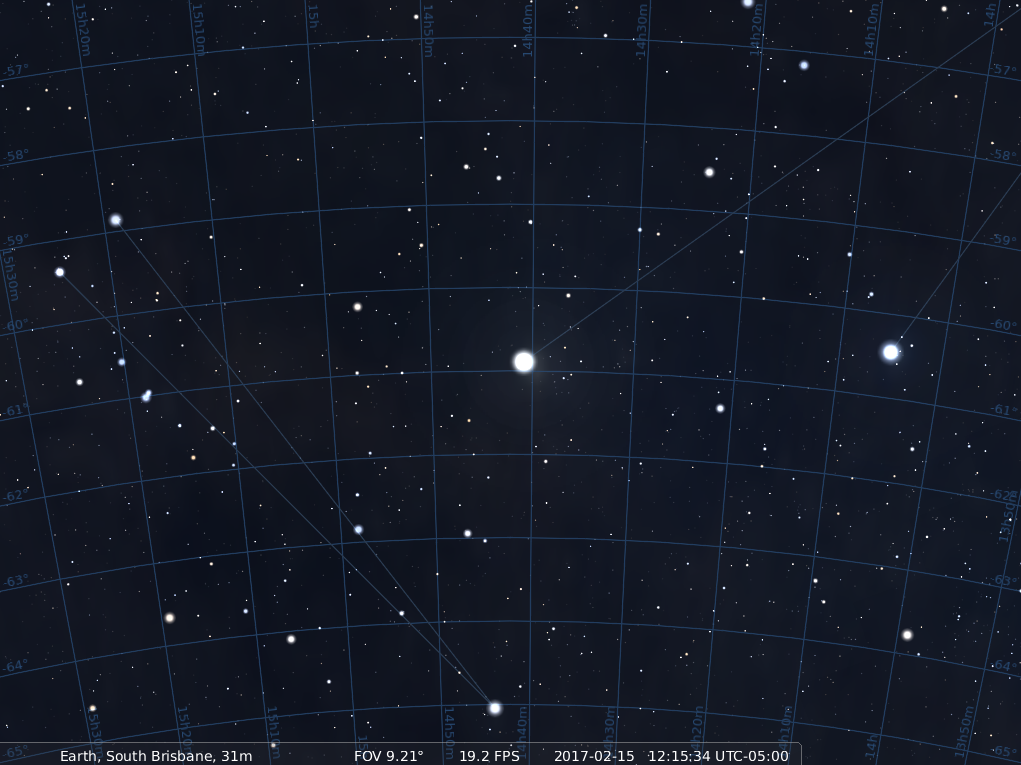
Let's zoom in a bit, so that our view is about 1 degree on a side. Alpha Cen is really bright, isn't it? It's actually the third-brightest star in the sky.
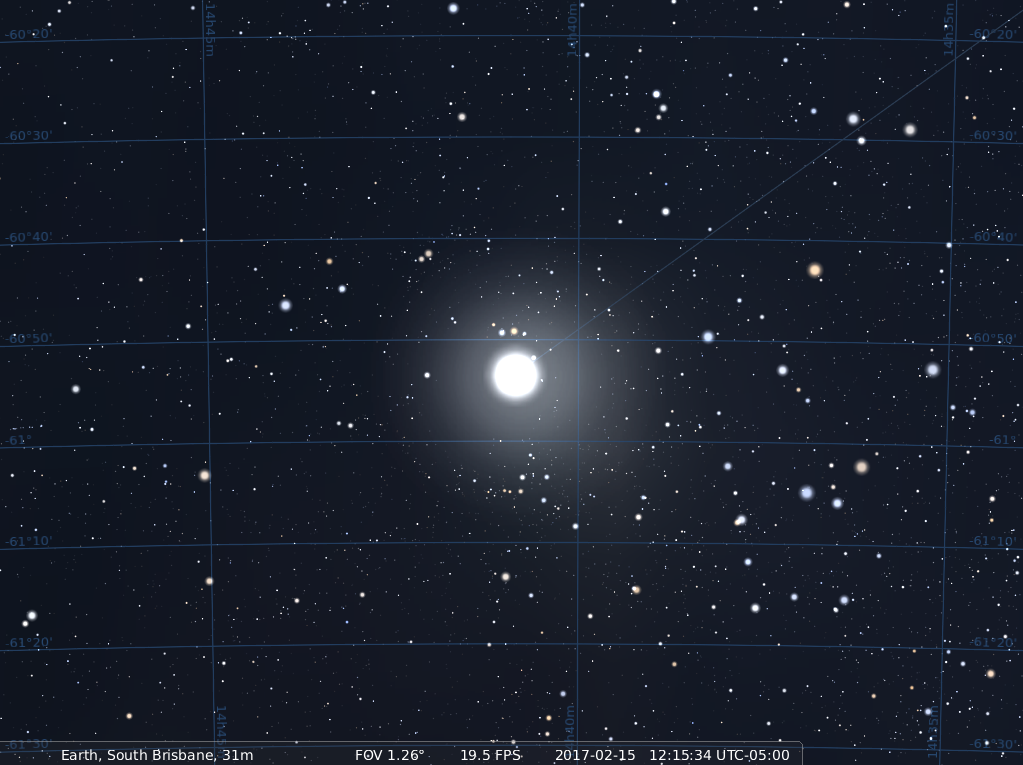
Q: What are the two stars brighter than Alpha Cen?
If we were to look through a telescope, we'd see that this very bright star is actually TWO stars: Alpha Centauri A and B.
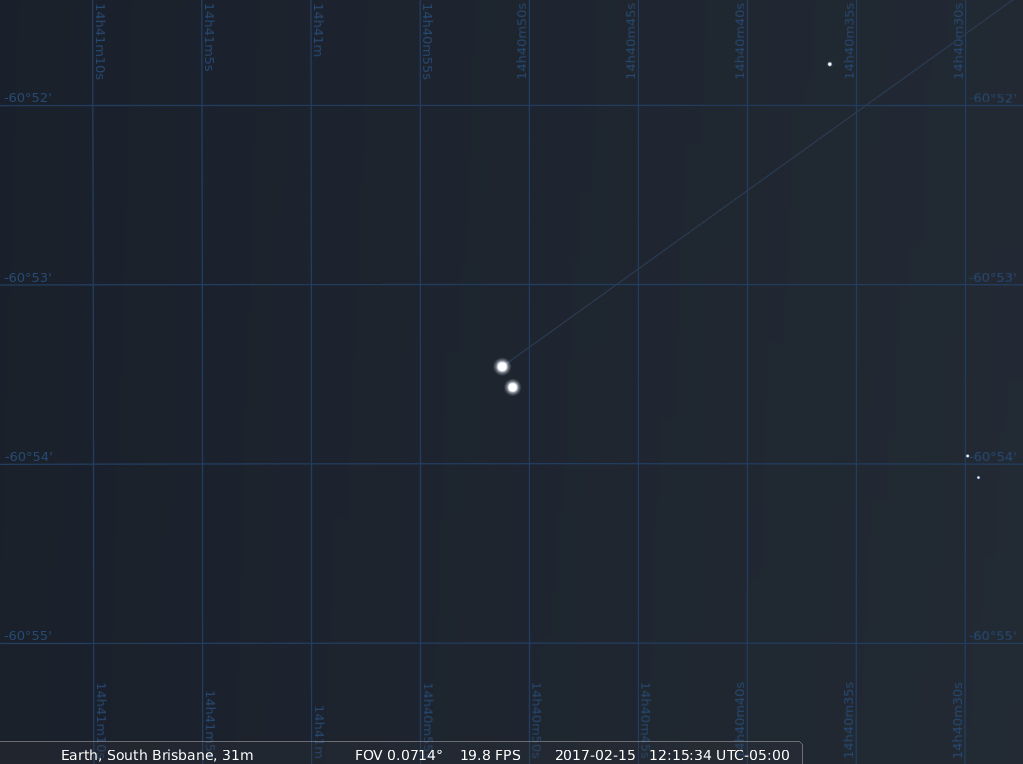
Those two stars are actually quite far apart. Compare the separation between them to the orbits of some of the planets in our Solar System.
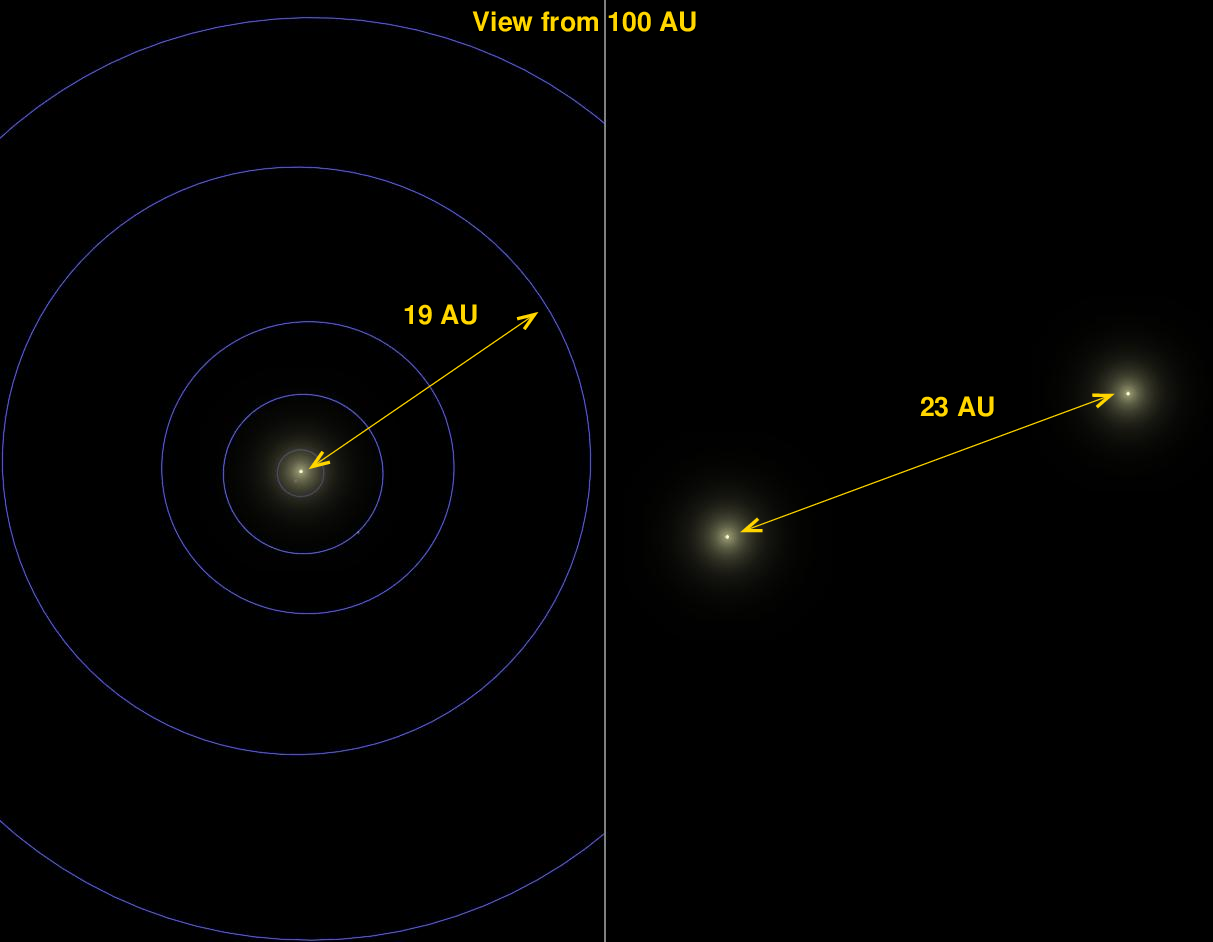
Now, remember, we are interested in Proxima Centauri, which is (probably) gravitationally bound to Alpha Centauri. So let's zoom back out a bit.

Q: Where is Proxima Centauri?
Well, actually, I played a little trick on you. Proxima Cen may be gravitationally bound to the two stars which make up Alpha Cen, but it appears quite far away from them. It's more than 1 degree away from them: about 2.2 degrees, in fact. So, to find it, we need to zoom back out:
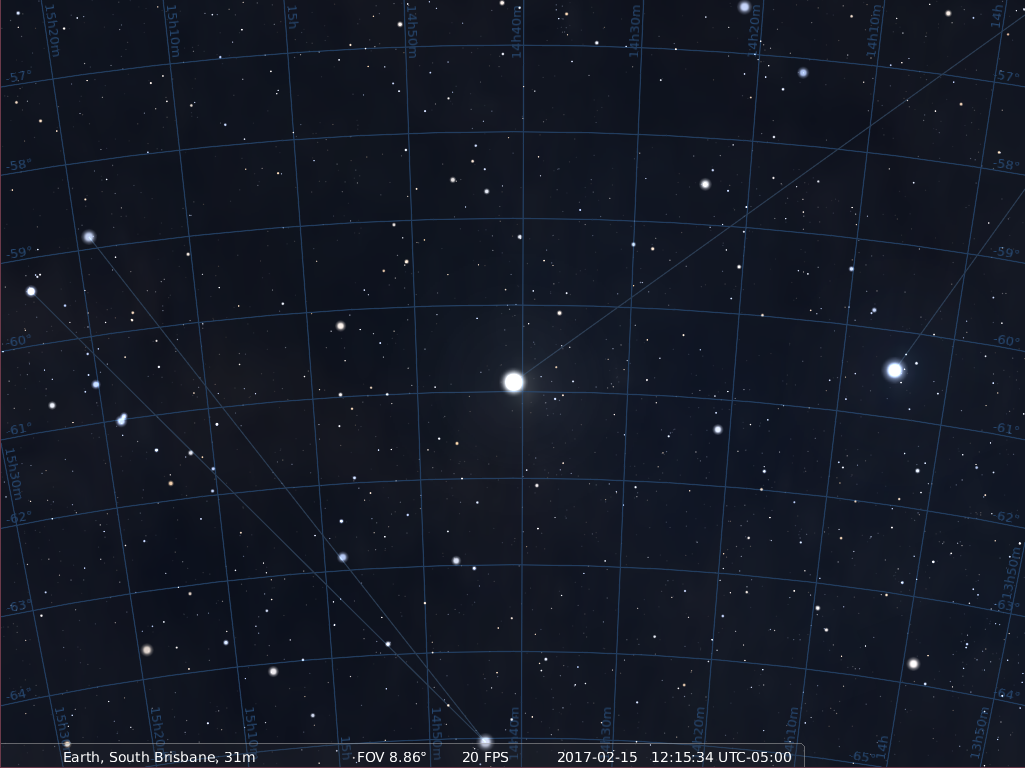
Q: Can you spot Proxima Cen now?
Here it is!
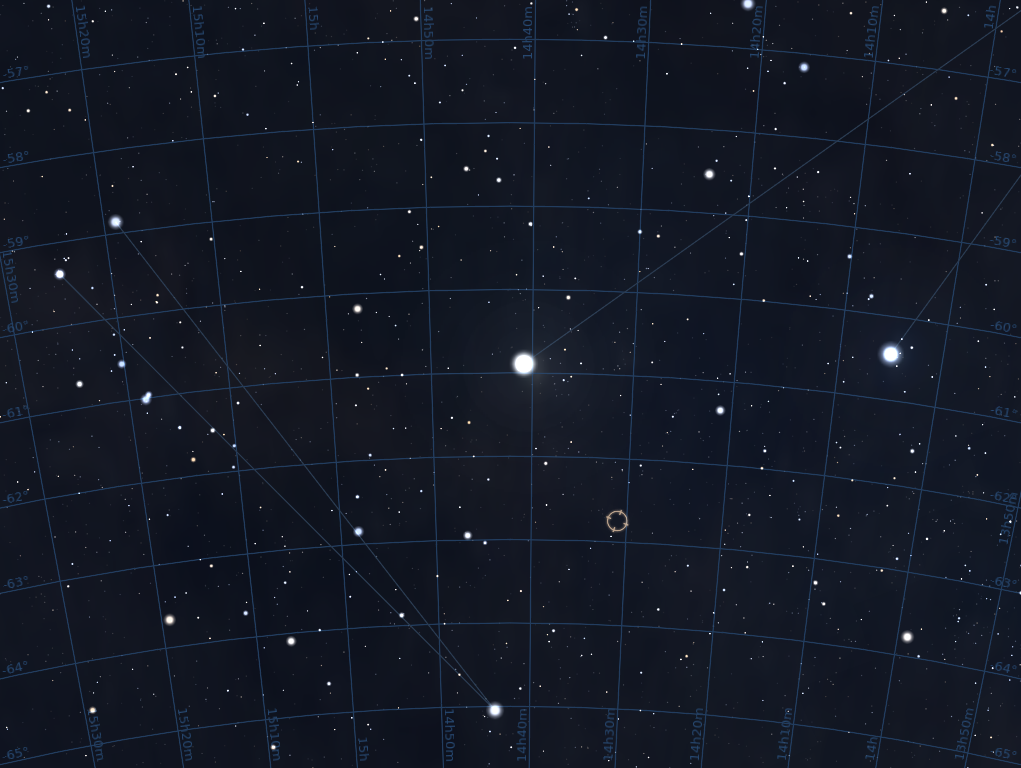
That's ... pretty far from Alpha Cen A and B, isn't it? Just how far? Well, let's go back to a bird's eye comparison of our Solar System and Alpha Centauri. If we float only 100 AU above each, we can see the orbits of the major planets around the Sun, and the two members of the Alpha Cen binary.

But this view won't show Proxima.
So, let's zoom out by a factor of 15 or so. Can we see Proxima yet?
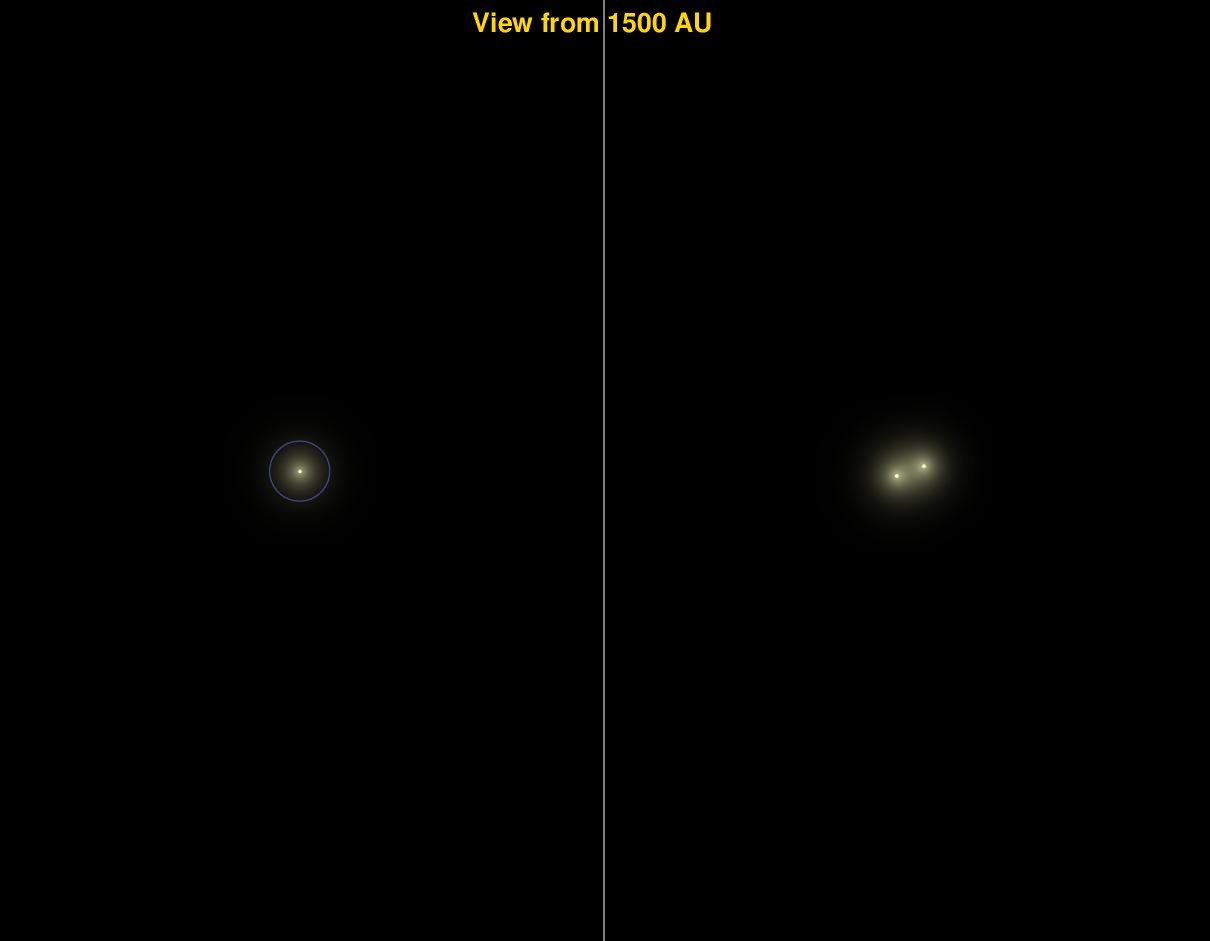
Nope.
If we want to see Proxima, we need to zoom out again by another factor of 70 (roughly); to such a great distance that we can't distinguish Alpha Cen A from its companion B, nor see any of the planets circling our Sun.
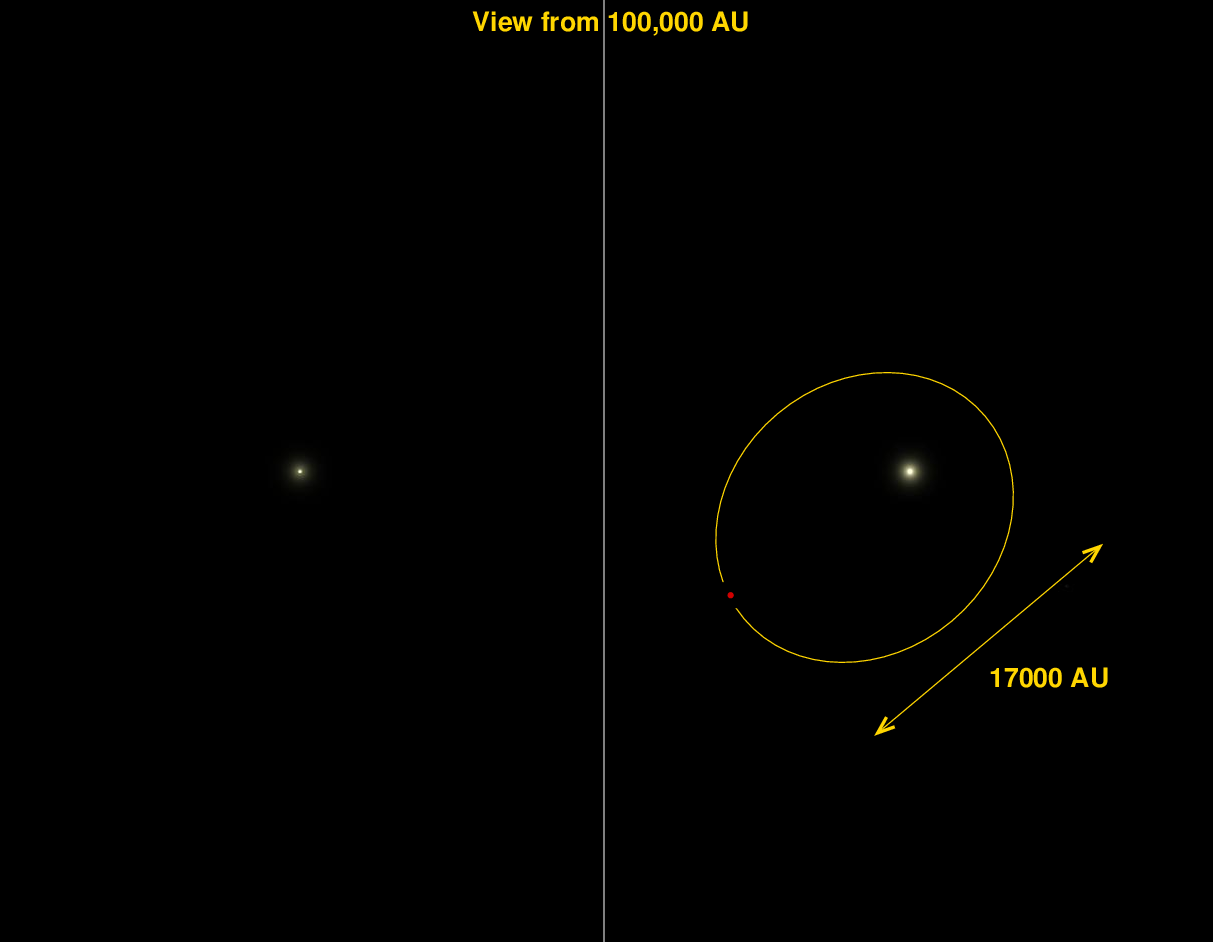
So, Proxima Cen is very, very far from its "big brothers". It's still not completely settled that their gravitational pull binds them together, though Kervella et al. (A&A 598, L7, 2017) argues that Proxima is bound in an orbit about 17,000 AU in diameter.
That sounds like quite a big distance ... until you compare it to the distance between stars.
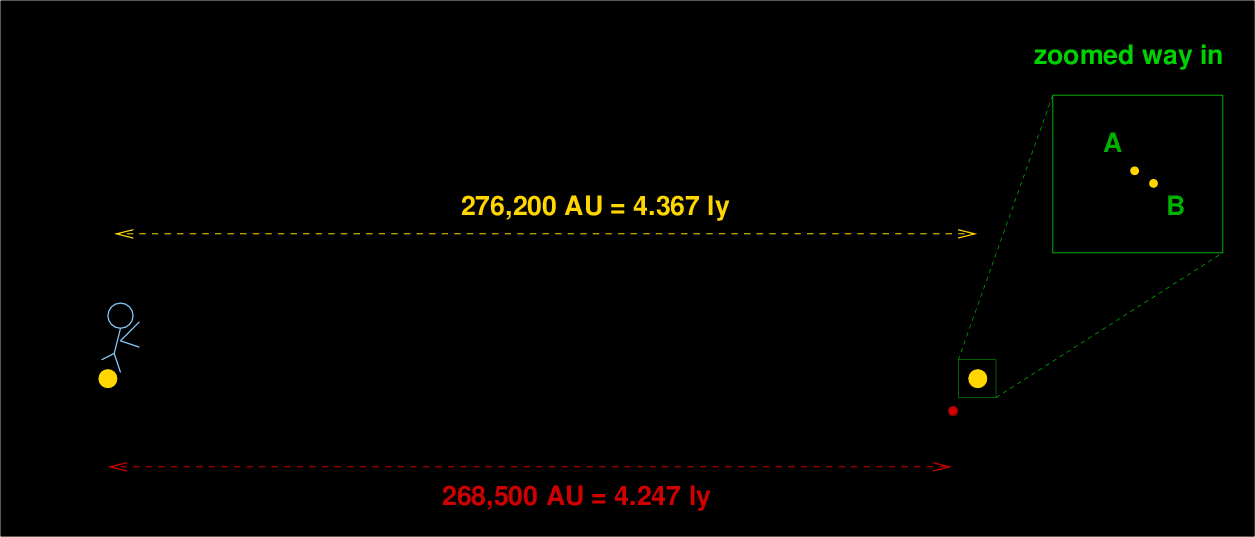
Note that Proxima is slightly closer to us than Alpha Cen A and B, and thus does deserve its name.
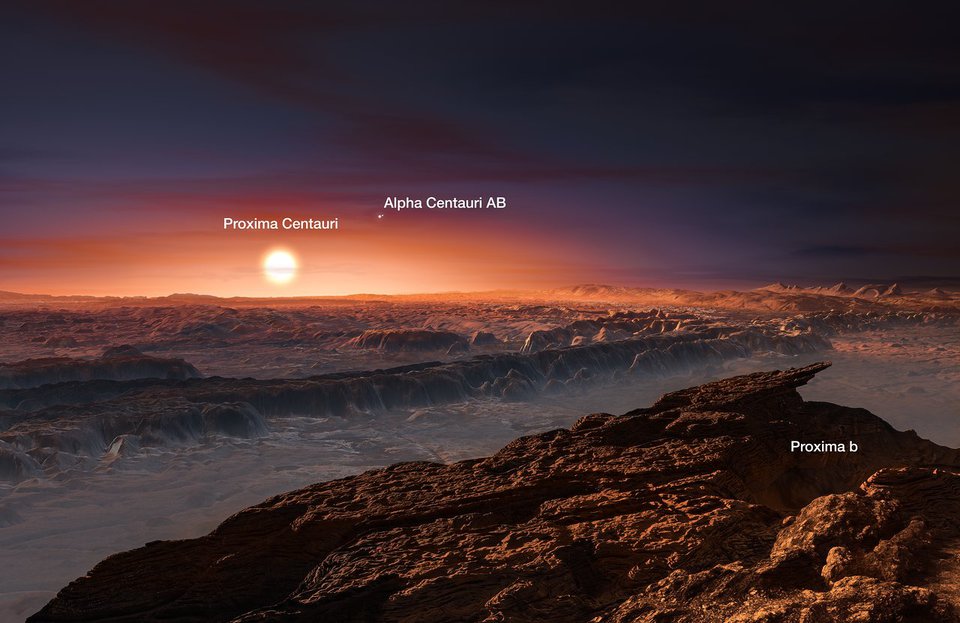
Image credit:
ESO/M. Kornmesser
On August 24, 2016, the European Southern Observatory announced the discovery of a planet around Proxima Centauri. Not only is this the star closest in space to our Solar System, but the planet was said to be within the star's habitable zone.
The news made headlines around the world. Within days, people were dreaming of ways that we could visit this new world.
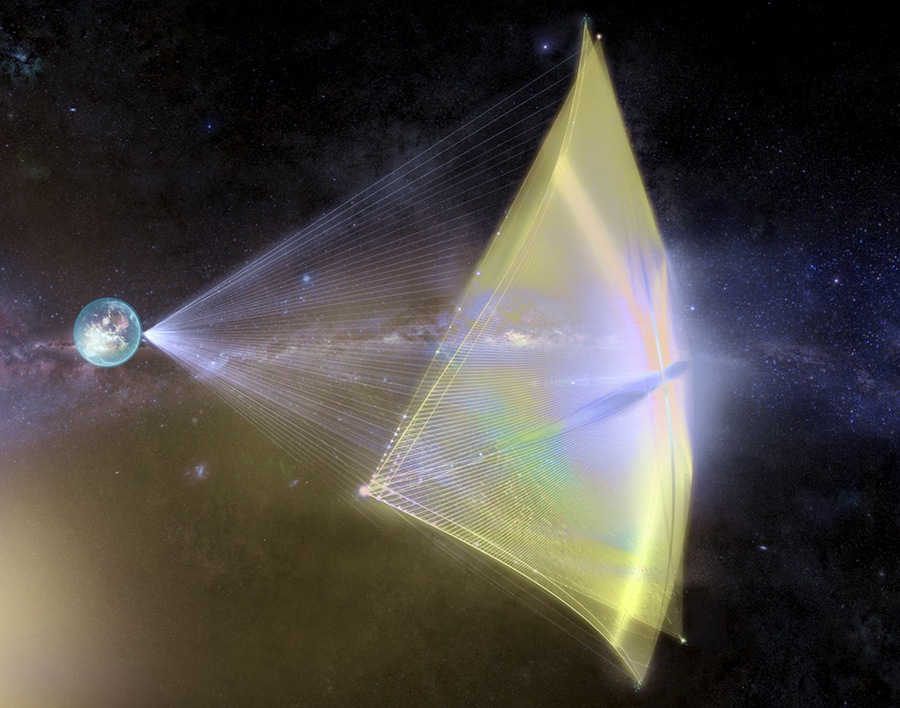
Image courtesy of
the Breakthrough Initative
There are many questions about this newly-found planet.
In the past six months, astronomers have been VERY busy: observing the star Proxima Centauri, trying to detect the planet in several ways, thinking hard about its environment and the properties it might have.
Let's try to address a few of these questions over the next 45 minutes or so. If you have any questions afterwards, just check out those papers listed above :-)
Astronomers used the European Southern Observatory's 3.6-m telescope in Chile

Image credit:
H&H Heyer/ESO
to send light into the High Accuracy Radial velocity Planet Searcher (HARPS), a spectrograph with VERY high precision. In order to prevent small temperature changes from affecting the results, HARPS lives inside a metal tank ...
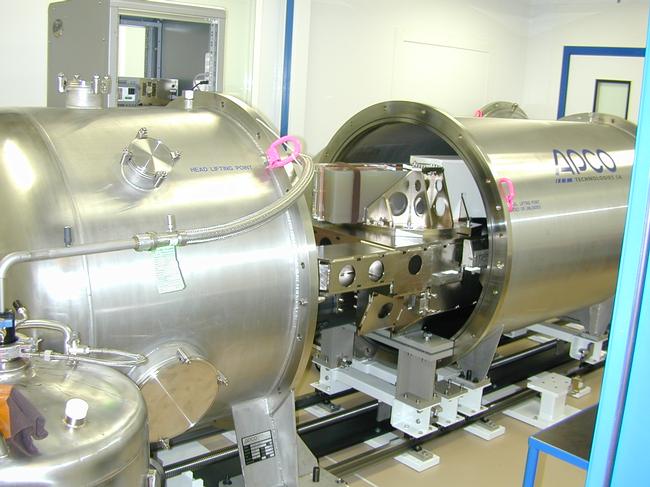
Image credit: ESO
... which sits inside a temperature-controlled room:

Image credit: ESO
Astronomers at ESO used spectra acquired with HARPS over the past few years to measure the speed with which Proxima Centauri is moving towards us. It has an average speed of about 22,400 meters per second, but if you look very carefully -- VERY carefully -- you might see small variations. During the period from January to April, 2016, for example, they measured the following radial velocities:
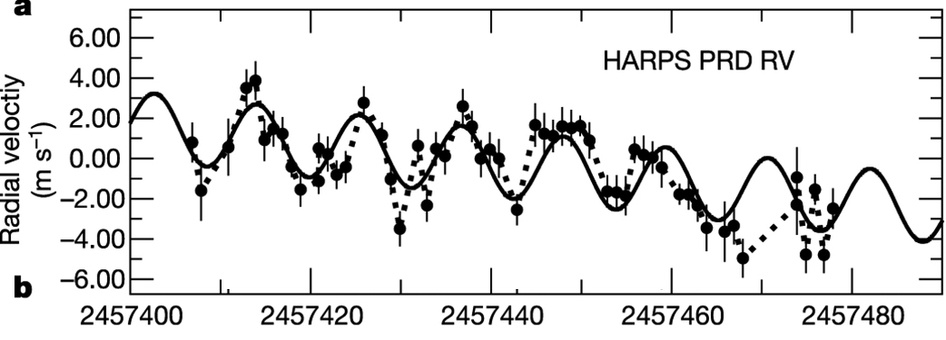
Figure 3 from
Anglada-Escude et al., Nature, 536, 437 (2016)
slightly modified by MWR.
Q: How large are the variations? Just how fast is that? Q: What is the period of these changes?
Now, why should the star Proxima Centauri be changing its velocity like this: first a bit slower, than a bit faster, then a bit slower, than a bit faster?
Well, if there were a planet orbiting Proxima Cen, then its gravity would tug on the star, causing it to move a tiny little bit towards us, then away from us, then towards us, then away from us ...
The tricky bit is the tiny little bit: because a star has a much larger mass than a planet, it will respond to the mutual gravitational pull much more subtly than the planet does.
In the case of our own Solar System, the Sun and Jupiter orbit their common center of mass with a period of about 12 years. Jupiter circles this center of mass with a speed of about 13,100 meters per second, but the Sun, travelling around a much smaller orbit, moves at only about 12 meters per second.
Just what can we tell about the planet Proxima Centauri b from its gravitational effects on its host star? Well, not much, I'm afraid. The two relevant radial velocity results are:
Astronomers have also determined some properties of the star itself in previous studies. Among these are:
How can we use this information to determine properties of the planet? Well, we can start with a relationship first noted by some dude named Kepler:

Here,
P is the period of a planet's orbit around its star
M is the mass of the star
(assumed to be much greater than mass of planet)
a is the semi-major axis of the planet's orbit
We know all the values except for a, the radius of the planet's orbit; so, we can re-arrange the equation to solve for that radius. We find
a = 0.05 AU
Hmmm. That sounds ... small. Remember that the Earth's orbit around the Sun has a semi-major axis of size 1.0 AU.
So, this is a view of the inner Solar System:
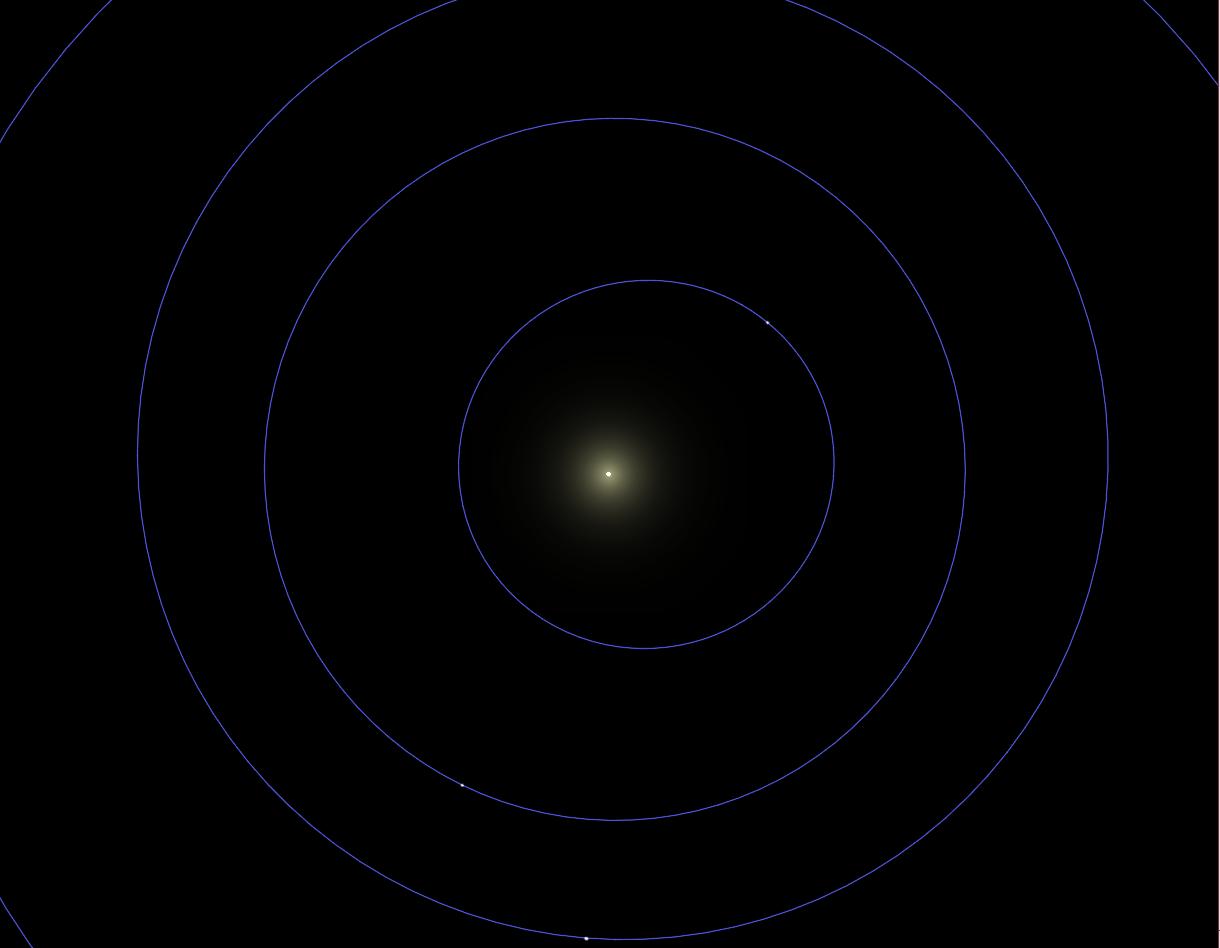
And THIS is what it would look like if we put the orbit of Proxima Cen b into its appropriate place:
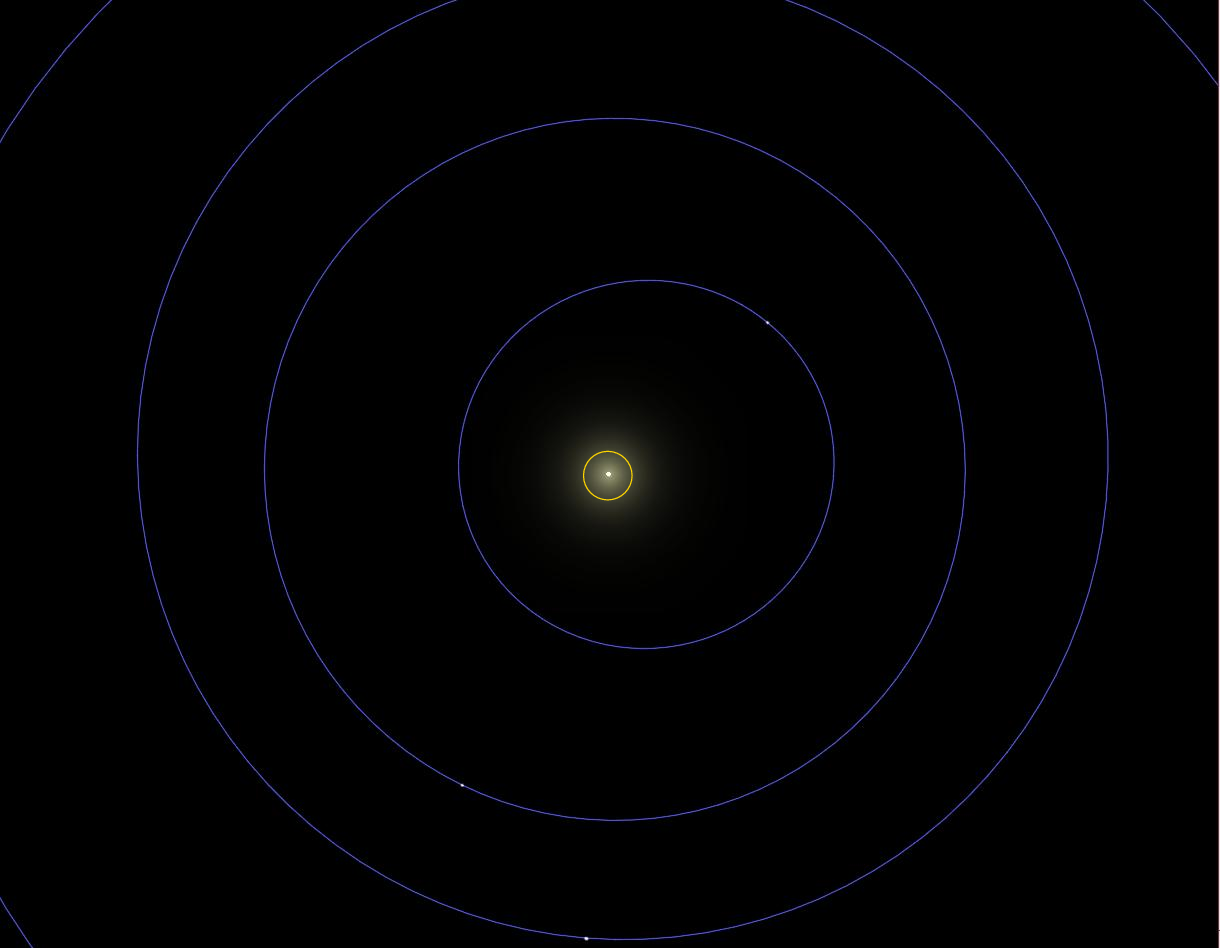
So, Proxima Cen b orbits its host star at a small distance.
There's another quantity we can determine from this information: the mass of the planet. Remember, we actually observe the motion of the star due to the gravitational force exerted by the planet. Since we know the distance between the two objects, and, in this case, we have a good estimate for the mass of the star, we can deduce the mass of the planet.
For Proxima Cen b, it turns out to be
?
Mass (Prox Cen b) = 1.3 * MEarth = 7.6 x 1024 kg
Gosh. A planet with a mass roughly the same as that of our good ol' Earth. That sounds like a good place to visit.
But -- wait a minute. Why is there a question mark above the equals sign in the equation above? The problem is a weakness of the radial velocity technique: it only measures the motion of the host star (and, therefore, the planet) in ONE DIMENSION: along the line of sight.
Now, if the orbits of the planet and host star just happen to be oriented edge-on from our point of view, like this, then there's no problem: our measurement of the planet's mass will be accurate.

But if the orbit is inclined to our line of sight, then our radial velocity measurements will only capture a fraction of the full motion of the star; and that will cause us to underestimate the true mass of the planet pulling it.
For example, both the planets shown below will yield exactly the same radial velocity measurements -- even though one is twice the mass of the other.
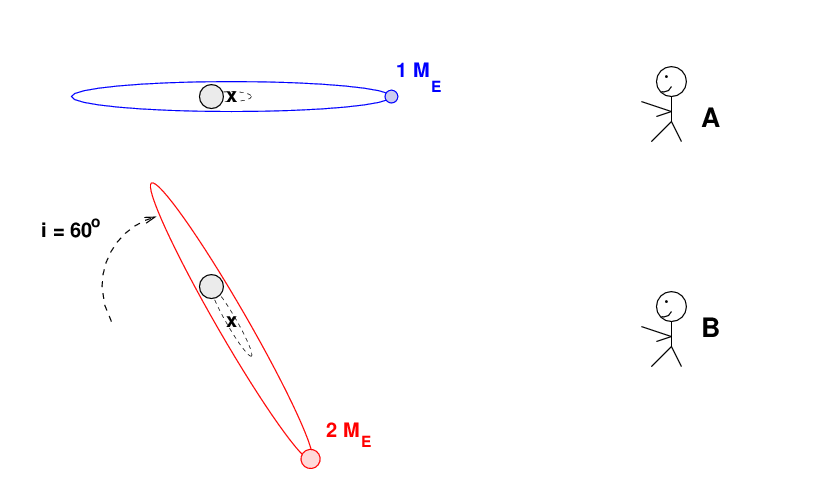
In fact, the masses of planets derived by radial velocity measurements alone are always underestimates. The true mass depends on the inclination angle of the orbit, like so:

In other words, a proper assessment of the mass of the planet circling Proxima Cen is
Mass (Prox Cen b) ≥ 1.3 * MEarth = 7.6 x 1024 kg
One thing we know very securely is that this planet comes very close to its host star. Look again at a picture of its orbit, compared with those of the planets in our Solar System:

Mercury is a hot, hot planet, with daytime surface temperatures of roughly 650 K ( Yan et al., Advances in Space Research, 38, 583, 2006 ). If Proxima Cen b is only one-eighth as far from its star, doesn't that mean that it will be even hotter -- and, therefore, an inhospitable place?

Homer Simpson is copyright Fox Broadcasting Company
Q: Does this mean Proxima Cen b must be
way too hot for humans to visit easily?
It would, if the star Proxima Centauri was similar to our Sun. But, of course, it isn't.
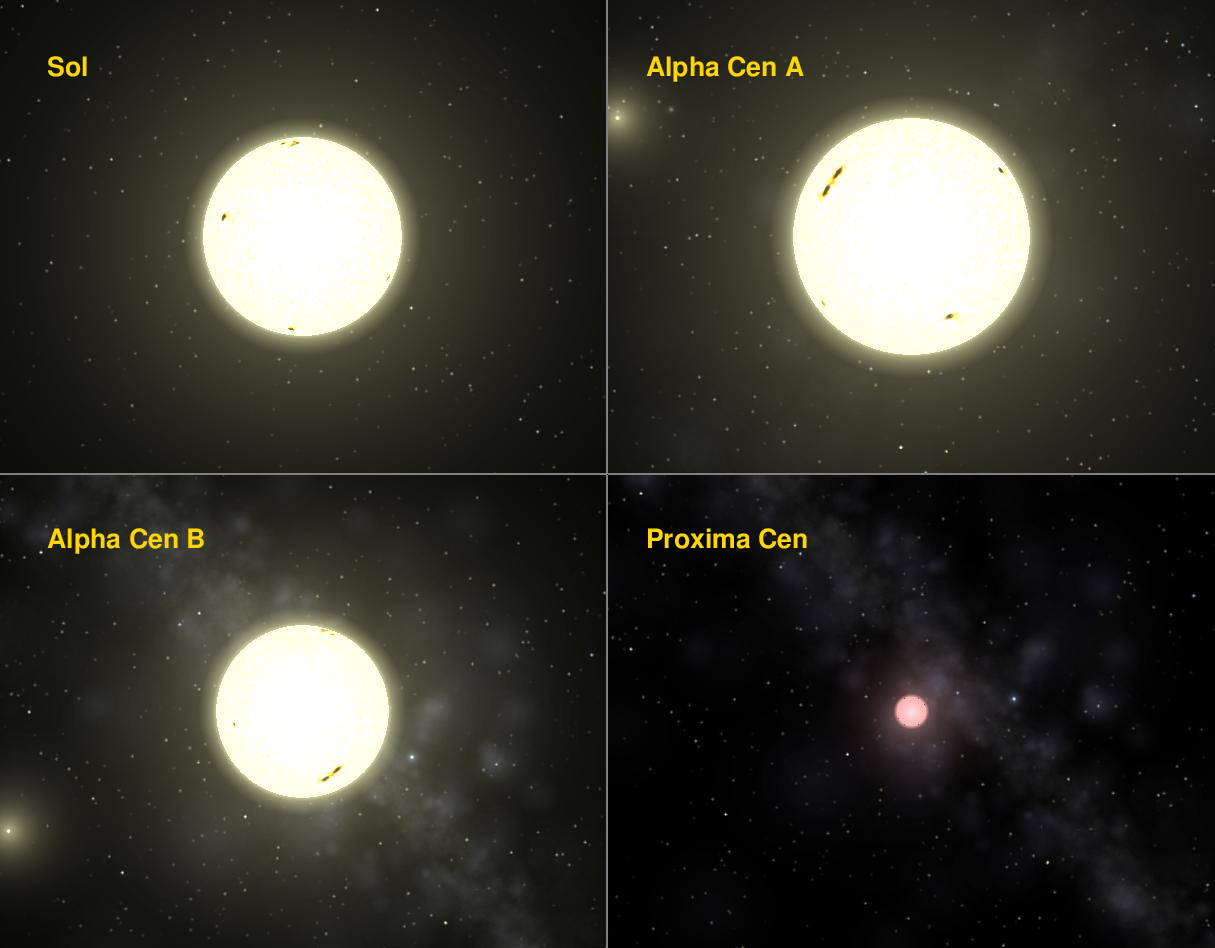
Proxima Cen is both smaller than our Sun, and much cooler. Put those two factors together, and you end up with a much lower luminosity. Remember?
Now, what's the connection between the luminosity of a star, and the temperature of some planet orbiting it? In real life, there are many complications, but we can make a very simple model like so.
First, consider the radiation from the star which strikes the planet and warms it up. We'll ignore complications such as the albedo of the planet.
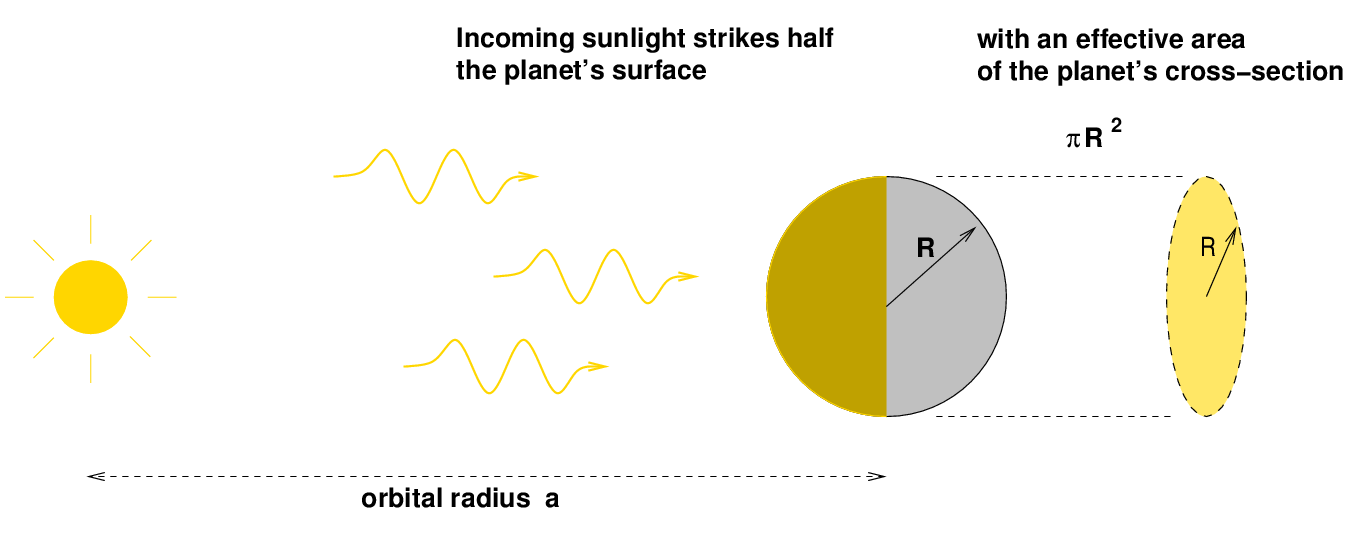
We can derive the amount of incoming energy striking the planet each second:

Now, if we simplify a LOT and assume that the entire planet has exactly the same temperature, and ignore the emissivity of its surface, we can figure out the amount of energy that it radiates away into space each second due to thermal radiation:
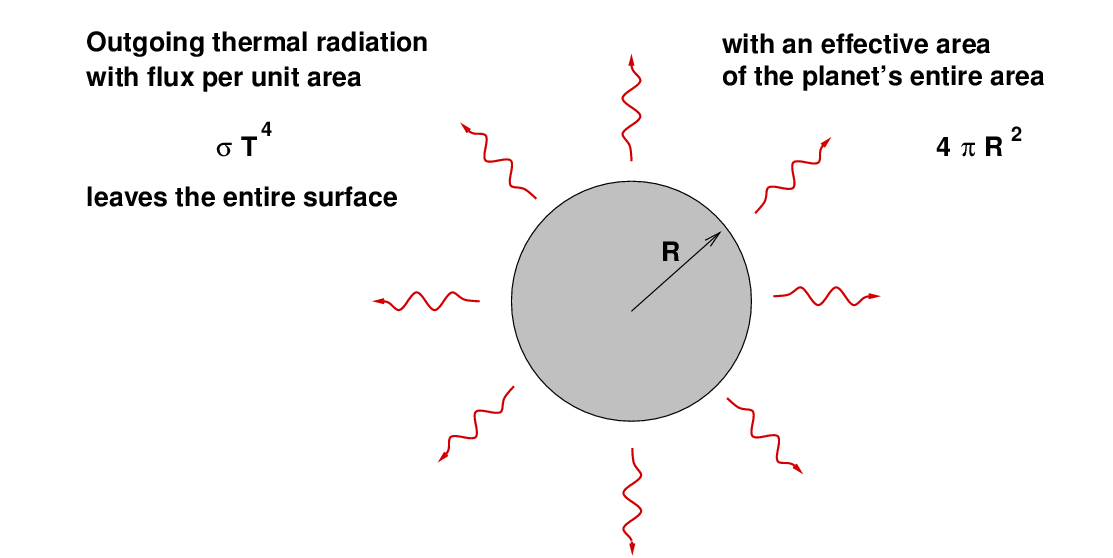

When the incoming and outgoing fluxes of energy are equal,

the planet will reach a steady equilibrium temperature T.

Look at the right-hand side of the equation -- it contains two terms that will be different for Earth and Proxima Cen b.
stellar luminosity L orbital radius a
------------------------------------------------------------------
Earth 1.0 solar 1 AU
Prox Cen b 0.00155 solar 0.05 AU
------------------------------------------------------------------
Being so close to its star tends to make it HOT, but orbiting such a low-luminosity star tends to make it COLD. Maybe these two differences could cancel each other out ...
When we compare the equilibrium temperature of Prox Cen b to that of the Earth, we end up with a ratio that looks like:
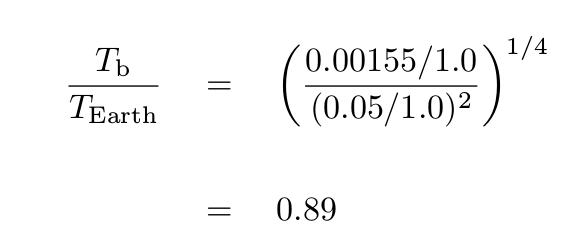
In short, the equilibrium temperature of Proxima Centauri b is predicted to be just a bit lower than Earth's -- very roughly 234 K = -29 Celsius. That's cold, sure, but no worse than the province of Alberta, Canada, in January.

Homer Simpson is copyright Fox Broadcasting Company
So, we can figure out the mass of the planet, and estimate its temperature; but what about its size? Does it have a radius similar to Earth's? If so, it would probably have a metallic and rocky composition, and a solid surface. If it was much larger, it might be a puffy gas midget, pretty, but not so practical. The radius would also have strong implications for the surface gravity of the planet.
One way to determine the size of a planet is to watch for a transit: if the planet crosses the visible face of the star, it will block some of its light, producing a dip in its intensity for several hours.
The Kepler spacecraft is really good at finding transits, and has detected several by objects the size of the Earth. But, alas, it has not (and will not) be pointed at Proxima Centauri.
A somewhat less famous space telescope is MOST: it is somewhat smaller than Kepler, but can still make precise measurements of stellar brightness. MOST did look at Proxima, but ...

Here is a figure from that paper showing their best candidate for a transit which has (roughly) the same period as the planet detected by radial velocity methods. The authors describe at length why they are not convinced by this signal -- if you look at the raw transit data at left, you will probably agree with them.
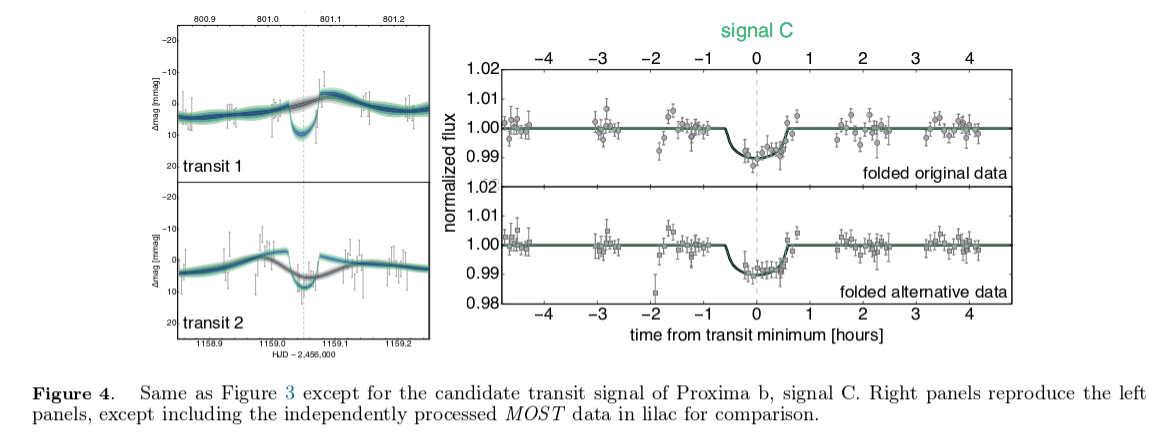
Okay, fine. We can't use the transit technique to measure the size of Proxima Cen b -- but is there some other way?
How about direct imaging? You know -- just take a picture.
Well, the problem is that the planet orbits very close to its host star -- the angular separation is just 0.037 arcsec. Yikes!
Astronomers have tried to see it, though, using adaptive optics (an instrument called SPHERE) on a very big telescope (the 8.2-meter Very Large Telescope). In a recently published paper, Mesa et al. (MNRAS 466, L118 (2017) show their best results after several nights of observing.
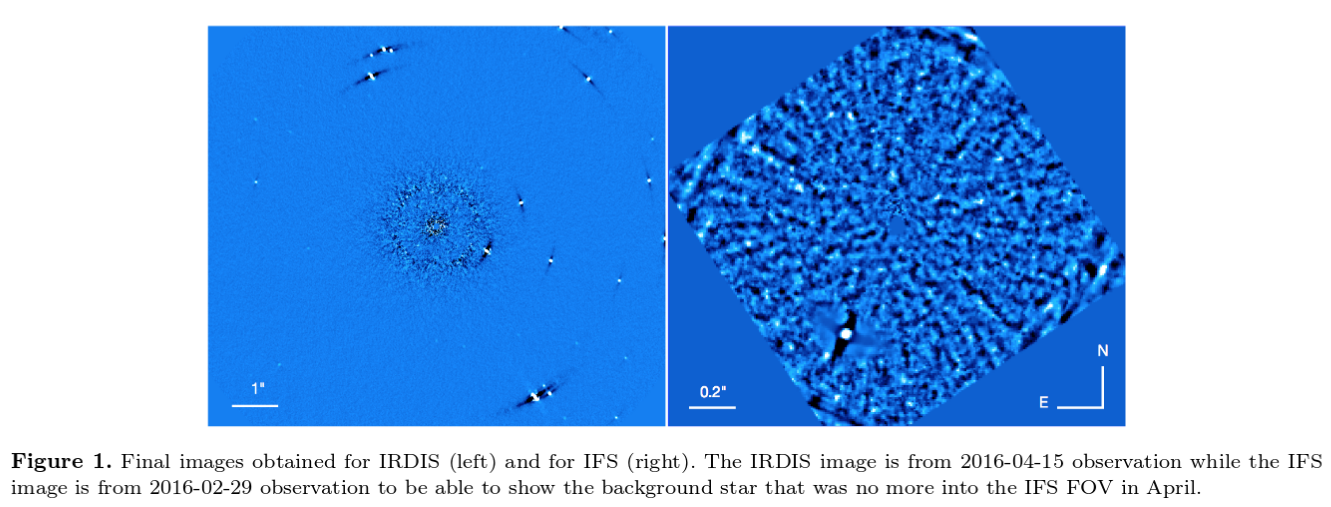
Figure 1 taken from
Mesa et al., MNRAS 466, L118 (2017)
Q: Do you see a planet at about 0.037 arcsec?
I don't, and neither did the authors. The best instruments we have right now just can't do the job. Mesa et al. tried to figure out how close to the star they COULD detect objects of various sizes -- take a look.
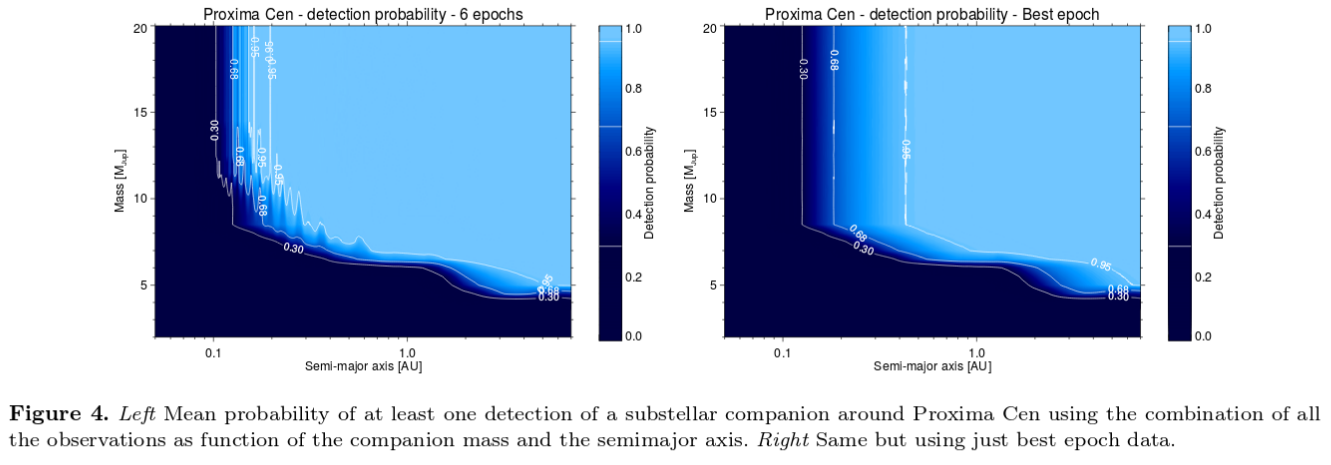
Figure 4 taken from
Mesa et al., MNRAS 466, L118 (2017)
Q: What is the probability of detecting an object of
mass about 1 Earth-mass = 0.003 Jupiter-mass
at a distance of 0.04 arcsec?
Sigh. We just don't know how big the planet is.
Many people would agree that a planet is much more interesting if it has an atmosphere; the chances of supporting some sort of life seem higher. So, does Proxima Cen b have an atmosphere?
Well, for the same reasons mentioned above that we can't take images of the planet, we can't use spectroscopy -- either in transmission (because we haven't detected transits) or emission (because we can't see the atmosphere directly). So, we must rely on indirect arguments.
One of these arguments uses the temperature of a planet to estimate the speeds of molecules in its atmosphere. We can compare those velocities to the escape velocity from the planet, and estimate how many molecules might fly off into space each second (or day, or year). This method provides an estimate of the thermal escape time of an atmosphere.
A very recent paper on arXiv describes this method in detail, and applies it both to planets in our Solar System, and to exoplanets. In brief, atmospheres around bodies to the lower-right of the pale green diagonal line should NOT escape over long periods of time, while those to the upper-left of that green line SHOULD escape.
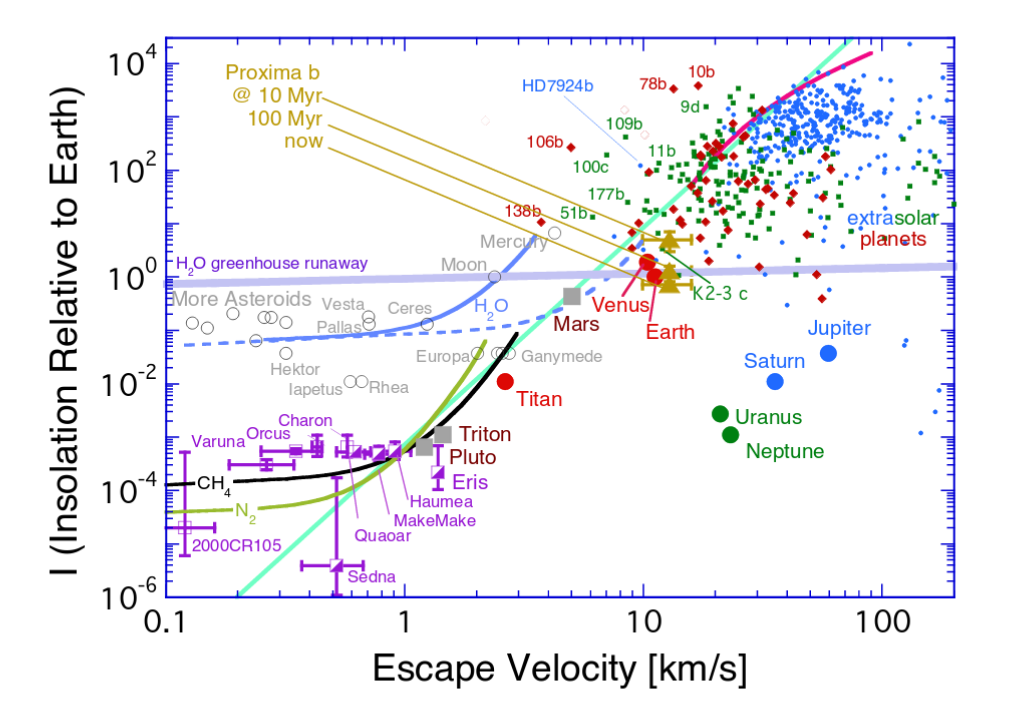
Figure 1 taken from
Zahnle and Catling (2017)
Q: Based on thermal arguments, might Proxima Centauri b
have an atmosphere?

HOWEVER .... another very recently published paper points out that there is a physical effect that many studies (including the one mentioned above) do not take into account.
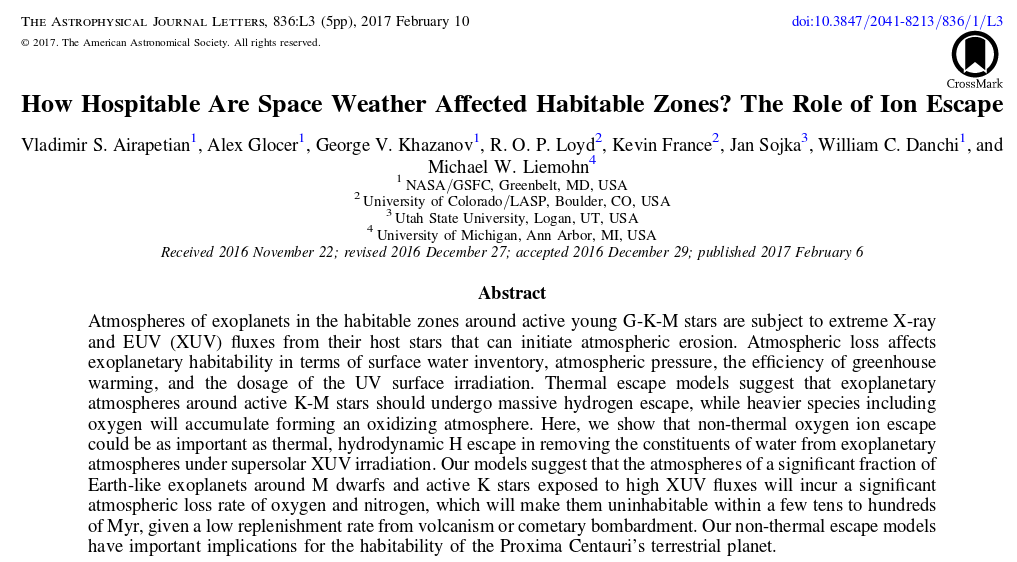
Abstract of
Airapetian et al., ApJ 836, 3 (2017)
The basic idea is that if an ultraviolet photon with high energy happens to run into an atom of, say, oxygen, in the upper atmosphere of a planet, that photon may ionize the atom. The free electron may then collide with nearby atoms and gain enough energy to reach escape velocity. When enough electrons have left the planet, the atmosphere will build up enough positive charge to encourage ions to leave, too.
Click on the image below to watch my version of the story.
Now, ordinary stars emit mostly optical photons, which do NOT have enough energy to ionize most atoms. However, if a star happens to flare, small regions of its atmosphere may heat up to tens or hundreds of thousands of degrees, emitting a great many UV photons.
Does Proxima Centauri ever flare? The MOST satellite watched it closely for many weeks, and, well, look for yourself.
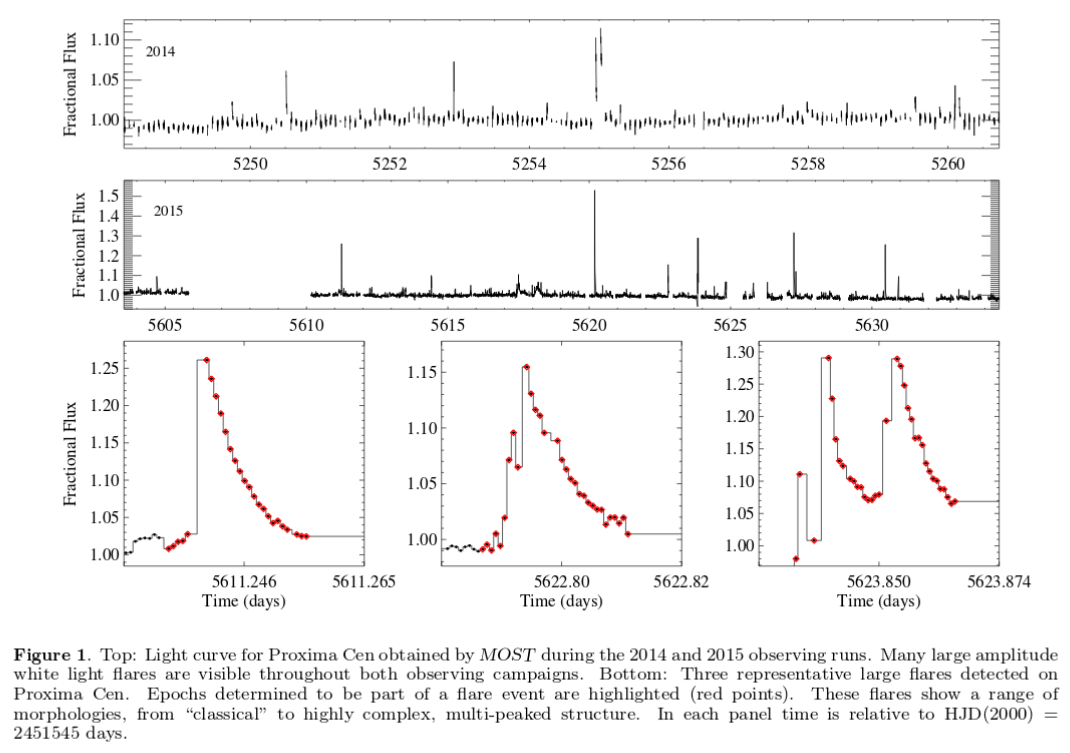
Figure 1 taken from
Davenport et al., ApJ 829, L31 (2016)
The MOST scientists wrote:
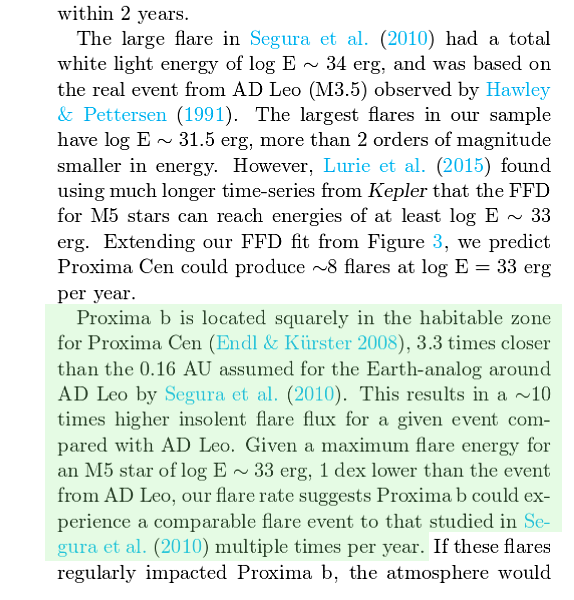
Text from Section 5 of
Davenport et al., ApJ 829, L31 (2016)
So, if you put together the ion escape mechanism and frequent flares on Proxima Centauri, what are the implications for an atmosphere on its planet? Airapetian et al. say the following:
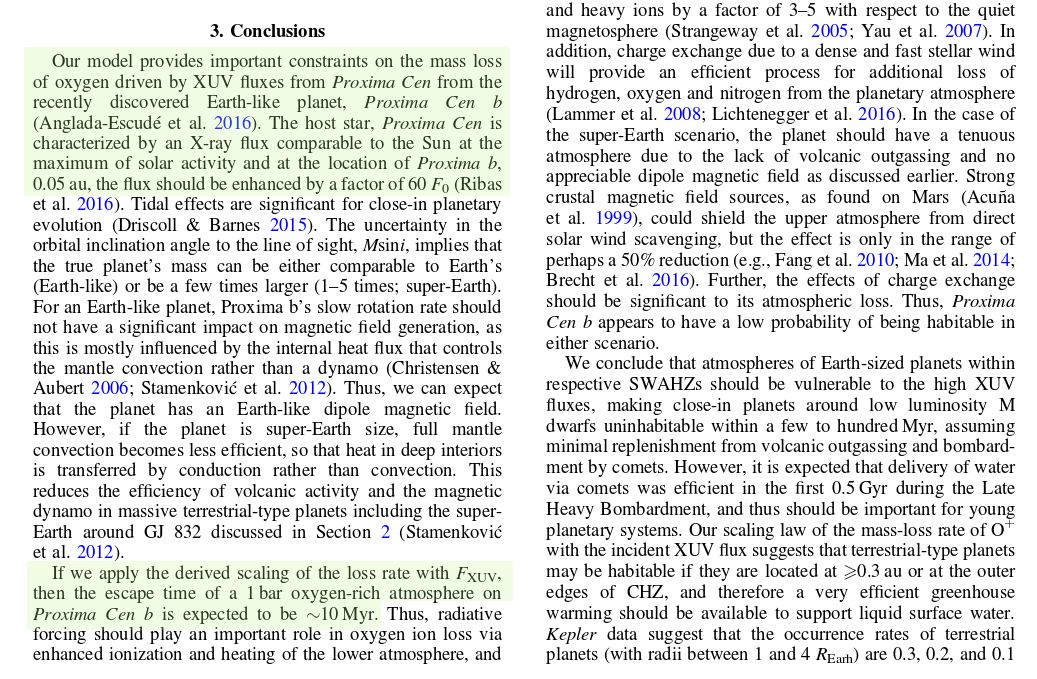
Taken from
Airapetian et al., ApJ 836, 3 (2017)

Homer Simpson is copyright Fox Broadcasting Company
 Copyright © Michael Richmond.
This work is licensed under a Creative Commons License.
Copyright © Michael Richmond.
This work is licensed under a Creative Commons License.